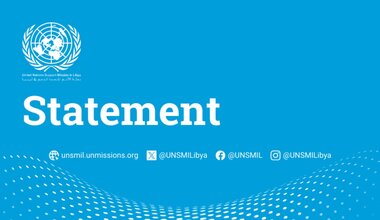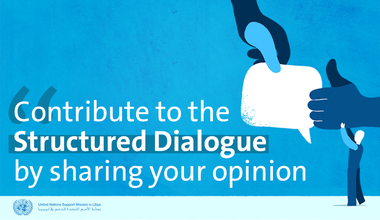Human Rights Report on Civilian Casualties - October 2016
Tunis, 1 November 2016 – From 1 October to 31 October 2016, the United Nations Support Mission in Libya (UNSMIL) documented 102 civilian casualties, including 29 deaths and 73 injured, during the conduct of hostilities across Libya. Victims included 7 children killed and 13 injured, 3 women killed and 6 injured, 19 men killed and 33 injured and 21 persons injured whose age and sex was unknown.
Civilian Casualties
The majority of civilian deaths were caused by shelling (9 deaths and 30 injured) and airstrikes (8 deaths and 22 injured), while the next leading cause of death was gun shots (3 deaths), then an unidentified explosion (4 deaths, 18 injured) and explosive remnants of war (1 injured). In the case of 5 deaths and 2 injured, the cause was not able to be verified.
UNSMIL documented 19 deaths and 64 injured in Benghazi, 5 deaths and 2 injured in Zawiya, 2 deaths and 6 injured in Tripoli, 1 death and 1 injured in Derna, 1 death in Sirte, and 1 death in Surman.
The civilian casualties included 2 women and 5 children killed from airstrikes in Qanfouda, a neighbourhood of Benghazi where civilians are trapped because of fighting between the Libyan National Army (LNA) and the Benghazi Revolutionaries Shura Council (BRSC). Casualties also included the injury of 5 boys from shelling in a playground in Benghazi, a Dutch journalist killed by a sniper in Sirte, a woman killed and 6 injured in a Tawergha internally displaced persons camp and 4 civilians killed and 18 injured from an explosion in al-Kish square in Benghazi. One of the civilians was Muhammad Bugaighis, an anti-corruption activist. Civilians were also caught in the fighting in Zawiya. Due to the ongoing intense hostilities the number of casualties recorded for the month of October (5 dead and 2 injured), is likely to increase as information will be confirmed.
While no one claimed responsibility for the air strikes, information received indicated that the LNA or their allies carried out the airstrikes that caused civilian casualties in Qanfouda and Derna. On 17 October, the BRSC issued a statement in which it warned those that conducted airstrikes on Qanfouda that they would be rightful targets. The statement was issued shortly after the shelling that caused civilian casualties in Benina (5 boys injured) and the same day as civilian casualties were caused in Syria Street, Benghazi (1 child killed, 1 child and 1 adult injured). UNSMIL has been unable to determine whether the BRSC were responsible for these attacks and which other parties caused civilian casualties in October.
Civilian Facilities
On 15 October, airstrikes hit the electricity plant in Derna. The hospital in Zawiya was unable to operate from 28 October, since it was in the direct vicinity of hostilities.
Other Casualties
On 27 October, 10 bodies were found with their hands tied and gunshot wounds in a rubbish dump in the Sheibna neighbourhood of Benghazi, which is under the control of the LNA. This follows another similar incident, in July 2016, in which 14 bodies were found with signs of torture and gunshots in the al-Leithi neighbourhood of Benghazi.
Note
The figures for civilian casualties set out above only include persons killed or injured in the course of hostilities and who were not directly participating in the hostilities. The figures do not include those casualties that are not a direct result of hostilities, for example executions after capture, torture or abductions, or casualties caused as an indirect consequence of hostilities. The figures are based on information UNSMIL has gathered and cross-checked from a broad range of sources in Libya, including human rights defenders, civil society, current and former officials, employees of local governments, community leaders and members, witnesses, others directly affected and media reports. In order to assess the credibility of information obtained, where possible, UNSMIL reviewed documentary information, including medical records, forensic reports and photographic evidence.
The figures are only those that UNSMIL was able to document in the reporting period. They are not likely to be complete and may change as new information emerges about incidents involving civilian casualties that took place during this period.
Similarly, while UNSMIL has systematically tried to ensure that the cases it documented are based on credible information, further verification would be required to attain a higher standard of proof. Due to the security situation, UNSMIL has not been able to carry out direct site visits in Libya to obtain information. Disruption in communications especially in areas controlled by groups pledging allegiance to ISIL and fear of reprisals against sources further hamper information gathering.
While not all actions leading to civilian casualties breach international humanitarian law, UNSMIL reminds all parties to the conflict that they are under an obligation to target only military objectives. Direct attacks on civilians as well as indiscriminate attacks – which do not distinguish between civilians and fighters – are prohibited. Attacks that are expected to cause incidental loss of civilian life, injury to civilians and damage to civilian objects excessive to the anticipated concrete and direct military advantage are also prohibited. Such attacks amount to war crimes that can be prosecuted by the International Criminal Court.
In order to ensure greater protection of the civilian population and essential infrastructure, all parties engaged in fighting in Libya must cease the use of mortars and other indirect weapons and imprecise aerial bombardments in civilian-populated areas, and not place fighters or other military objectives in populated areas. All executions of captives must cease and all those captured including fighters must be treated humanely in all circumstances. Murdering or torturing captives is also a war crime, regardless of what the captive may be accused of.
 United Nations Peacekeeping
United Nations Peacekeeping UN
UN









